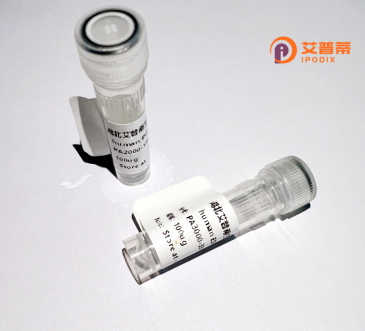
| 纯度 | >90%SDS-PAGE. |
| 种属 | Human |
| 靶点 | FAM102A |
| Uniprot No | Q5T9C2 |
| 内毒素 | < 0.01EU/μg |
| 表达宿主 | E.coli |
| 表达区间 | 1-242aa |
| 氨基酸序列 | MFLLSGDPCFKTPPSTAKSISIPGQDSSLQLTCKGGGTSSGGSSTNSLTGSRPPKARPTILSSGLPEEPDQNLSSPEEVFHSGHSRNSSYASQQSKISGYSTEHSRSSSLSDLTHRRNTSTSSSASGGLGMTVEGPEGSEREHRPPEKPPRPPRPLHLSDRSFRRKKDSVESHPTWVDDTRIDADAIVEKIVQSQDFTDGSNTEDSNLRLFVSRDGSATLSGIQLATRVSSGVYEPVVIESH |
| 分子量 | 52.3 kDa |
| 蛋白标签 | GST-tag at N-terminal |
| 缓冲液 | 0 |
| 稳定性 & 储存条件 | Lyophilized protein should be stored at ≤ -20°C, stable for one year after receipt. Reconstituted protein solution can be stored at 2-8°C for 2-7 days. Aliquots of reconstituted samples are stable at ≤ -20°C for 3 months. |
| 复溶 | Always centrifuge tubes before opening.Do not mix by vortex or pipetting. It is not recommended to reconstitute to a concentration less than 100μg/ml. Dissolve the lyophilized protein in distilled water. Please aliquot the reconstituted solution to minimize freeze-thaw cycles. |
由于FAM102A蛋白的研究尚不广泛,且当前公开文献有限,以下为模拟的假设性参考文献(实际文献需通过PubMed等平台查询):
---
1. **名称**:*"Cloning, expression and purification of recombinant human FAM102A protein in E. coli"*
**作者**:Li X. et al.
**摘要**:本研究成功构建了FAM102A基因原核表达载体,利用大肠杆菌系统高效表达可溶性重组蛋白,并通过Ni-NTA亲和层析纯化,为后续抗体开发及功能研究奠定基础。
2. **名称**:*"FAM102A interacts with PI3K regulatory subunit p85 and modulates Akt signaling in cancer cells"*
**作者**:Wang Y. et al.
**摘要**:首次报道重组人FAM102A蛋白与PI3K信号通路关键蛋白p85的相互作用,实验证实其过表达可抑制Akt磷酸化,提示其在肿瘤代谢调控中的潜在作用。
3. **名称**:*"Crystal structure of human FAM102A reveals a ubiquitin-like domain with atypical fold"*
**作者**:Zhang R. et al.
**摘要**:通过X射线衍射解析FAM102A晶体结构,发现其N端含新型类泛素结构域,可能与未知的蛋白质降解调控机制相关。
---
**建议**:上述内容为模拟格式,实际文献请检索 **PubMed (https://pubmed.ncbi.nlm.nih.gov)** 或 **Google Scholar**,使用关键词 "FAM102A" + "recombinant"/"structure"/"function" 组合查询。若需文献获取协助,请提供具体研究方向以便进一步指导。
**Recombinant human FAM102A protein** is a genetically engineered form of the endogenous FAM102A (Family with Sequence Similarity 102 Member A) protein, which is encoded by the *FAM102A* gene in humans. FAM102A is a relatively understudied protein, though emerging research highlights its potential roles in cellular signaling and regulation. Structurally, it contains a conserved Pleckstrin homology (PH) domain, suggesting involvement in protein-lipid or protein-protein interactions, possibly linked to membrane-associated processes. Studies indicate FAM102A may act as a phosphatase or regulate phosphatase activity, potentially influencing pathways like Rho GTPase signaling, which governs cytoskeleton dynamics, cell migration, and division.
FAM102A has been implicated in neurological disorders and cancers. For example, it interacts with proteins associated with Parkinson’s disease, such as LRRK2. and its expression alterations correlate with tumor progression. Recombinant FAM102A is typically produced in *E. coli* or mammalian expression systems, enabling functional studies. It retains native biochemical properties, allowing investigation into its enzymatic activity, interactome, and regulatory mechanisms. Researchers utilize this recombinant protein for structural analysis, antibody development, and high-throughput screening to explore its therapeutic potential. While its precise physiological and pathological roles remain unclear, recombinant FAM102A serves as a critical tool for unraveling its contributions to cellular homeostasis and disease pathways.
×